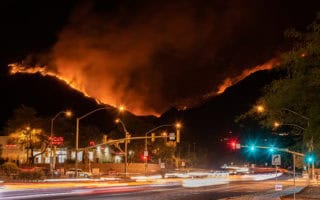
A view of the forest fires in California at night
Take a look at this USA Today coverage from just a couple of weeks ago.
“In Los Angeles, air quality was between good and moderate in the early parts of the day on Tuesday,” writes Ignacio Calderon. “By sunrise on Wednesday, however, air quality reached hazardous levels that threatened people’s health.”
That’s how quickly things can change, as wildfires rage in Southern California. Strong winds bring the combustion and the smoke closer to local communities. It’s scary.
But the coverage also illustrates a broader trend. We see that this kind of sudden air pollution is happening more often than it used to. Calderon cites EPA data that shows how this is happening around the country, without specifying what that data is. However, EPA resources include this chart in a set of “climate change indicators” posted online.
Changes in Air Quality Over Time: What America is Facing
What Calderon points out in the piece is that over the last few decades, America made progress in terms of improving pollution.
A significant number of the new threats are from wildfires. In 2017, wildfire smoke became more harmful than either fossil fuels burning for electric generation, or factory pollution.
The problem is that like other kinds of combustion, wildfires create something called PM 2.5. This term refers to ultra fine particles that can get into the lungs and get embedded there. Some of this material can even get into the bloodstream. It tends (according to sources like this one from the California Air Resource Board) to aggravate respiratory conditions like:
- COPD
- Asthma
- Allergies
- Virus-induced respiratory trouble
Any of these conditions can be exacerbated by living in an area with poor air quality. And as Calderon points out, the air quality can change quickly….
More Statistics
Researchers found that in 2023, 140 million Americans Had at least a week of bad air quality.
That’s the highest levels that we’ve seen in a decade, according to Calderon’s coverage. Some blame Canadian wildfires like the one that draped the New York City skyline in smoke (for example, in the summer of 2023).
Calderon also provides testimony from doctors who give a more anecdotal picture of people getting sick from wildfire smoke. Some dole out more preventative asthma medications. Others see more family medicine patients coming in to get help.
PM 2.5: Long-Term Exposure and Effects
Sometimes we tend to think that PM2.5 exposure just leads to worsening respiratory incidents, but there are also long-term effects to consider.
Long-term exposure might lead to certain kinds of negative natal outcomes, or higher risk of heart attack and cardiovascular problems for older people.
Many doctors also feel the problem is worse in underserved communities.
Reading the Data
The EPA maintains an air quality index or AQI that you can look at to see what the air is like in your community. There’s even a clickable chart where users can get local information from the EPA.
And again, what people are finding is that wildfires play a big role in air quality.
Of course, it’s not just air quality – the fires ravage homes and businesses, compel people to evacuate their local areas, and destroy personal property at a troubling rate.
But the air quality is one of those less evident problems that people need to understand – a sort of secondary effect of these major conflagrations. The impact was wide-ranging, too- as the fires raged up north, states as far east as Kansas and Missouri were affected by poor air quality. Also, when the Canadian fires were active, states as far west as Minnesota and IL were affected.
How to Figure Out Your Own Air Quality
In addition to looking at the EPA charts and other resources for outside air, homeowners and heads of households can figure out how this is affecting the air inside their homes. Use an air monitor to get a read on what’s present in your indoor air, and at what levels.
This is the air that most of us breathe more on a regular basis. We spent a significant amount of time in our homes, and in our workplaces, where air quality can be just as bad.
The key is for both families and business owners or managers to use air monitors to see what’s present in the indoor air, and then put air purifiers in place to scrub out harmful contaminants.
Floor-standing or whole-home air purifiers can drastically reduce the amount of PM 2.5 in the air as well as other items like:
- · Dust mites
- · Mold spores
- · Volatile organic compounds
- · Pet dander
- · Pet odors
Take a look at modern appliance models that have the special features and designs that fit your needs. US Air Purifiers LLC will help you to find the right purchase, to feel better about the air inside of your home or business. Get peace of mind for your health, as we see uncertainty arise in modern life.